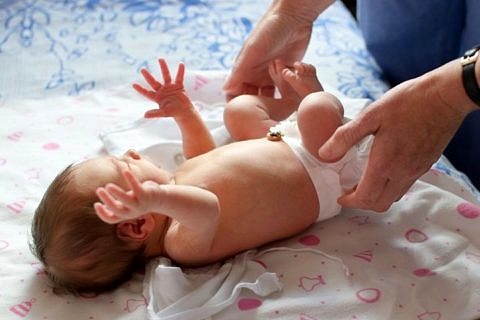How nerve cells control movements crucial for survival in newborns
Fast-moving babies
Babies are capable of moving extremely quickly. This is crucial to the development of the human nervous system. An international team of researchers involving FAU has now developed a method which can be used to quantitatively assess these movements at the level of the individual neurons. In future, this method could be used to detect disorders in the development of motor skills at an early stage.
Anyone who has changed a baby’s nappy knows all too well that although they may be tiny, newborns can move their limbs very quickly. These rapid movements allow robust connections to be formed in the nervous system and to ensure that the motor system works the way it should. An international team led by Prof. Dr. Alessandro Del Vecchio, assistant professor of Neuromuscular Physiology and Neural Interfacing at FAU, has researched the cause of these movements. They have developed a non-invasive method that demonstrates how human neurons control the movements of the limbs.
Rapid movements are important for the development of the nervous system
Special cells known as motor neurons are responsible for controlling muscle movements. They connect our brains to our muscles. In newborn infants, a great many of these motor neurons are extremely well synchronised, down to the millisecond. By emitting the same signals simultaneously, they contribute to successful connections being formed within the nervous system at this very early stage. Neurons which emit signals at the same time are more likely to connect. Their new method allows Del Vecchio and his team to identify to what extent individual motor neurons are involved in the infants’ movements.
Synchronised movements compensate for lack of muscle strength
The researchers have now discovered that the high degree of synchronisation in infants’ neurons also serves another purpose. Due to their weak muscles, young babies lack strength. They compensate for this, however, with a high degree of synchronisation, in other words by contracting the individual muscle fibres simultaneously. This allows infants to make movements necessary for their survival, such as reflexes, just a matter of hours after birth.
Early detection of motor disorders
A better understanding of the interaction between motor neurons and movement in infants may allow disorders in the development of motor skills to be detected and treated better in future. The non-invasive method developed by Del Vecchio can be used simply and painlessly with newborns.
As an assistant professor of Neuromuscular Physiology and Neural Interfacing, Prof. Dr. Alessandro Del Vecchio carries out his research at the newly established Department of Artificial Intelligence in Biomedical Engineering. Alessandro Del Vecchio’s professorship is one of a total of four assistant professorships established within the context of the d.hip Campus-bavarian.aim programme aimed at encouraging young researchers and launched by FAU and Siemens Healthcare GmbH.
Del Vecchio and his team have published their findings in the journal Science Advances. The original article is freely accessible online in English.
Further information
Del Vecchio A, Sylos-Labini F, Mondì V, Paolillo P, Ivanenko Y, Lacquaniti F, Farina D (2020) Spinal motoneurons of the human newborn are highly synchronized during leg movements. Science Advances, 20 Nov 2020: Vol. 6, no. 47, eabc3916, DOI: 10.1126/sciadv.abc3916
Prof. Dr. Alessandro Del Vecchio
alessandro.del.vecchio@fau.de
